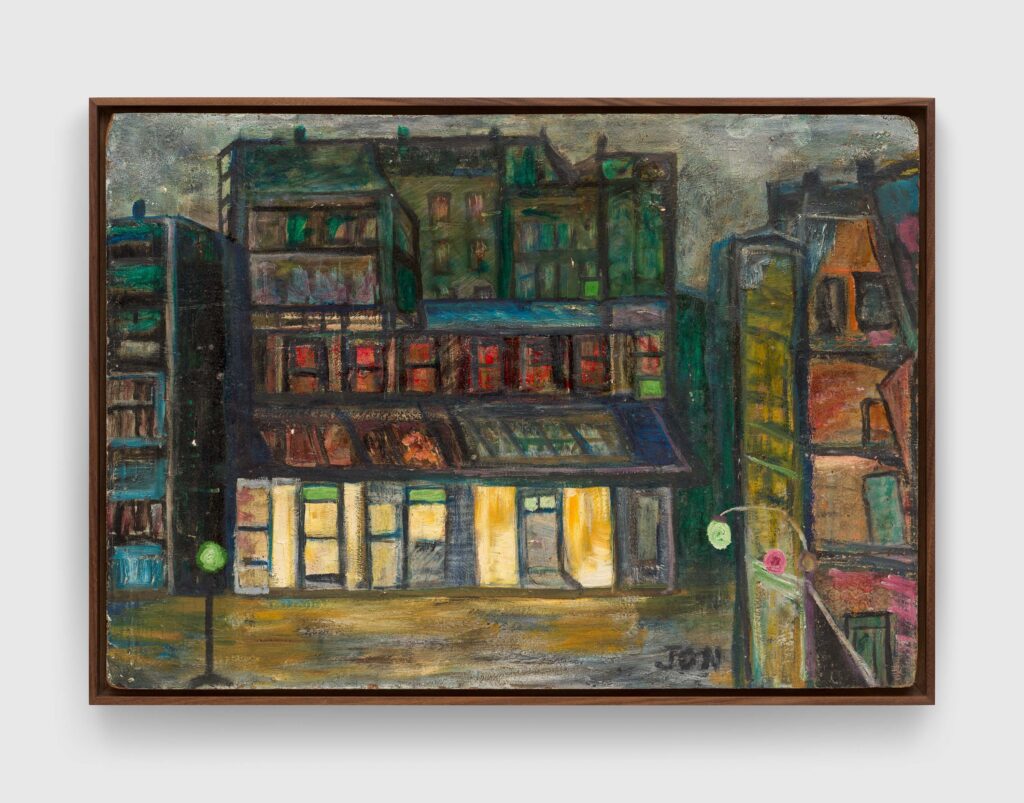Painter Jon Serl, Once Seen as an Outlier, Shines as an Idiosyncratic Master in ‘No Straight Lines’
Serl’s compositions hover somewhere between folkloric symbolism and magical realism, all rendered in a visual language that is stubbornly naïve.

‘Jon Serl: No Straight Lines’
Zwirner Gallery, 34 East 69th Street, New York, New York
Through October 26, 2024
Painter Jon Serl, once billed as an outsider, folkloric, or even an American primitive artist, is now the star of a new show at David Zwirner’s East 69th Street location. Placed with other American artists one might consider outliers, the show also seeks to undermine the very labels Serl struggled under during his unique career. This is a show that places Serl squarely in the history of modern and contemporary painting, as an idiosyncratic master in his own right.
The artist Sam Messer first discovered Serl in the 1990s, living alone in his rustically squalid cabin at Elsinore, California, where he rose at 3:00 am every morning to paint his signature oil on Masonite works amid his chickens and beloved dogs. A collaboration and friendship ensued. Mr. Messer promised Serl that his painting would be remembered, resulting in his tireless advocacy. The artist and collector Josh Smith, also a fan, joined forces with Mr. Messer to make this current show a reality.
Born in 1894 at Olean, New York, Serl was the son of a Vaudevillian family and began life treading the boards. He garnered notoriety for performing different characters, including a female drag persona named “Slats.” His work as a traveling actor led him all over North America doing all manner of odd jobs, including gardening for Howard Hughes and working as a voice over actor at Hollywood. During World War II he decided to devote his life to painting, and took up residence on the West Coast. He would continue to paint daily until his death in 1993 at the age of 99.
Entirely self-taught, Serl nevertheless was deeply familiar with the painting of his time, even as his approach to figuration, color, and form remained completely intuitive. His compositions hover somewhere between folkloric symbolism and magical realism, all rendered in a visual language that is stubbornly naïve.
“Untitled,” a Serl painting which greets gallery goers at the top of the stairs, is a perfect illustration of how his well-honed painterly instincts work together with an equally sophisticated eye and compositional logic. Consisting of seven figures grouped along a horizontal plane — group portraits were a popular subject for Serl — it is immediately striking for its divided background of deep maroon and red, and the equally intriguing and mask-like faces of its subjects.
Only after a few moments do odd inconsistencies come to light. The second figure from the left sports a vestigial, dwarf-like leg and foot that emanates from its thigh. Another figure is missing legs entirely and appears to float over a bucket. Pairs interact throughout the painting with gesticulating, ropy arms, but a lone figure in the middle stares off to the side, lost in contemplation. The context of the story behind this group is compelling, but murky.
The same with “Untitled with Red Background,” which appears to be a group of women bathing in a large public shower. A central figure sits on a bench and scrubs her foot, and what appear to be shower heads line the wall behind her. In between the shower heads, however, is a portrait of a man. What is a painted portrait doing in a public shower? These are the odd compositional decisions that lend dream-like drama to his scenes, perfumed with surreal humor.

These are not novelty paintings, however. There is a deeply realized sense of color and composition that shines through. “District,” a late-night cityscape with deft touches of green, rose, and red, transforms a sleeping apartment building into a beautifully contained, modernist grid, a dream of classic Bauhaus. Compositional balance of this sort does not come easily, and Serl pulls it off with aplomb.
One can see echoes of the Nabi, fauvism, and early German expressionism in Serl’s work, while the subject matter, often situated in landscape, recalls the other California plein air painters of his generation. His muted palette and use of blob like forms recall the similar work of similar painter from France, Gaston Chaissac, though it is unlikely they knew each-other. It is likely, however, that both were aware of early Kandinsky and James Ensor, who’s influence, especially in Serl’s rendering of mask-like faces bordering on the grotesque, shines through.
Other painters in this show demonstrate once again how indebted current contemporary painting is to its innovators and outliers. Mr. Smith stuns with his multicolored grouping of palm trees, once again showing how a fine-tuned color sense can complement simple forms. A young standout from this year’s Venice Biennale, Louis Fratino, contributes “Self with Pitcher and Candle,” an archly seductive interior scene that borrows fluidly from a dozen modernist sources. Dana Schutz, who is known for her utterly confounding figurative paintings, contributes “Driver,” which shows a troll-like figure grabbing a steering wheel from an extreme forced perspective. It’s wild in a way that is hard to fathom, which seems to be precisely the point.
All artists in this bear the stubborn imprint of “Americana,” or what could also be termed a fiercely independent spirit. This unlikely collaboration between Serl and Mr. Messer, who contributes his own affecting portrait of Serl painted on the day he died, is a testament to an utterly individual strain in American painting that informs contemporary art. We are richer for it.

